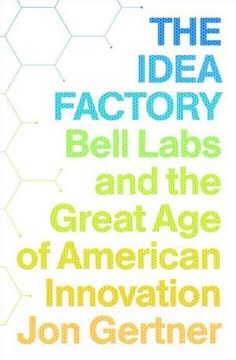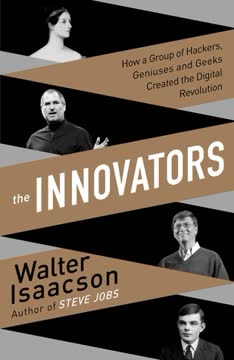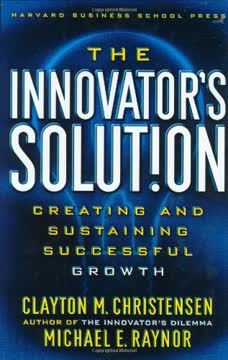Key Takeaways
1. Disruptive innovation transforms complex, expensive products into simple, affordable ones
The disruptive innovation theory explains the process by which complicated, expensive products and services are transformed into simple, affordable ones.
Disruptive innovations start by targeting overlooked segments with "good enough" offerings. They improve over time, moving upmarket and eventually displacing established products and companies. This pattern has played out across industries like computing, retail, and automobiles. In healthcare, examples include:
- Retail clinics staffed by nurse practitioners disrupting primary care practices
- Ambulatory surgical centers disrupting general hospitals
- Home dialysis machines disrupting dialysis centers
Disruptive innovations succeed by:
- Being simpler and more affordable than existing options
- Targeting "nonconsumers" or overserved customers
- Improving along a different trajectory than mainstream products
- Eventually becoming "good enough" for mainstream customers
2. Technological enablers, business models, and value networks drive disruptive innovation in healthcare
Three key lessons from the history of disruptive innovation are particularly important in the disruption of health care.
Three key elements enable disruptive innovation in healthcare:
-
Technological enablers: Tools and techniques that simplify complex problems and enable rules-based solutions. In healthcare, these include:
- Molecular diagnostics
- Imaging technologies
- Ubiquitous telecommunications
-
Business model innovations: New approaches to delivering and capturing value. Examples include:
- Retail clinics with nurse practitioners
- Focused hospitals for specific procedures
- Home-based care enabled by technology
-
Disruptive value networks: Systems of suppliers, distributors, and customers with aligned business models. This requires:
- Integration of technological enablers and business models
- Coordination among multiple disruptive innovations
- Overcoming resistance from existing healthcare institutions
Successful disruption requires all three elements working together synergistically. The healthcare industry's complex, interdependent nature makes this especially challenging but potentially transformative.
3. Hospitals and physicians' practices need to separate into focused business models
The hospital business model that has emerged from this conflation of activities is an extraordinarily complex and expensive one that lacks focus.
Hospitals and physician practices currently combine multiple business models, leading to inefficiency and high costs. They need to separate into focused models:
-
Solution shops: For diagnosing complex problems through iterative, intuitive processes. Examples:
- Specialized diagnostic centers
- Consultations for rare or complex conditions
-
Value-adding process (VAP) businesses: For treating well-understood conditions through standard processes. Examples:
- Focused surgical centers
- Chronic disease management clinics
-
Facilitated networks: For managing conditions requiring extensive patient involvement. Examples:
- Online communities for chronic disease patients
- Peer support networks for behavioral health
Benefits of separation:
- Improved efficiency and lower costs
- Better alignment of resources and processes with specific jobs to be done
- Increased transparency in pricing and quality measures
- Enables disruption by more focused, efficient business models
4. Retail clinics and facilitated networks will disrupt traditional healthcare delivery
Retail clinics, as VAP business models, can integrate the steps in this process in a way that optimizes the fulfillment of this particular job, consistently within 15 minutes or less and with no waiting.
Retail clinics staffed by nurse practitioners are disrupting primary care by offering convenient, affordable care for simple conditions. Key features:
- Located in pharmacies and retail stores
- Limited scope of services (e.g., flu shots, strep tests)
- Transparent, low pricing
- Extended hours and no appointments needed
Facilitated networks are disrupting chronic disease management by enabling peer support and information sharing. Examples:
- Online communities for patients with specific conditions
- Mobile apps for tracking symptoms and sharing data
- Telehealth platforms connecting patients with providers
These models succeed by:
- Focusing on specific, well-defined jobs to be done
- Leveraging lower-cost providers and technology
- Offering greater convenience and accessibility
- Empowering patients to manage their own health
As these models improve, they will take on more complex cases, further disrupting traditional healthcare delivery.
5. Precision medicine enables lower-cost venues and providers to do more sophisticated work
Once efficacy and reliability are assured, solutions once again become decentralized, as the basis of competition shifts toward convenience and other new metrics of performance.
Precision medicine is shifting care from intuitive to rules-based approaches, enabling:
-
Lower-cost providers to perform more complex work:
- Nurse practitioners managing chronic diseases
- Pharmacists administering vaccinations
- Patients self-managing conditions with technology
-
Care to move to more convenient, lower-cost settings:
- Retail clinics for simple acute conditions
- Home-based care for chronic disease management
- Telemedicine for remote consultations
This progression follows three stages:
- Intuitive medicine: Based on physician judgment and experience
- Empirical medicine: Using statistical correlations to guide treatment
- Precision medicine: Rules-based care based on exact diagnosis
Enabling technologies:
- Molecular diagnostics for precise disease identification
- Decision support tools integrating medical knowledge
- Remote monitoring devices for ongoing patient management
As more conditions move towards precision medicine, care will continue to decentralize and become more accessible and affordable.
6. Integrated fixed-fee providers and employers are best positioned to create disruptive value networks
Integrated fixed-fee providers aren't as captive to obsolete regulations as fragmented providers, in the following sense.
Integrated fixed-fee providers like Kaiser Permanente have key advantages in implementing disruptive innovation:
- Aligned incentives: Profit from keeping patients healthy, not from providing more services
- System-wide perspective: Can optimize across different care settings and provider types
- Control over full care continuum: Able to implement coordinated, disruptive business models
- Financial flexibility: Can invest in prevention and lower-cost care models that reduce long-term costs
Employers are also well-positioned to drive disruption:
- Long-term interest in employee health and productivity
- Ability to contract directly with innovative providers
- Motivation to reduce healthcare costs while improving quality
- Potential to integrate health management with other employee benefits
Key strategies for these entities:
- Investing in precision diagnostics and preventive care
- Implementing value-based payment models
- Leveraging technology for care coordination and patient engagement
- Partnering with disruptive innovators in healthcare delivery
By creating aligned disruptive value networks, these organizations can accelerate the transformation of healthcare.
7. Reimbursement reform is crucial for enabling disruptive innovation in healthcare
The reimbursement system is structured to sustain the status quo.
Current reimbursement systems hinder disruptive innovation in several ways:
- Fee-for-service incentivizes volume over value
- Administered pricing distorts market signals
- Complex billing codes make it difficult to introduce new care models
- Blanket contracting funnels patients to high-cost providers
Key reforms needed:
-
Separate true insurance from routine healthcare financing:
- High-deductible plans for catastrophic coverage
- Health savings accounts for routine care
-
Enable value-based payment models:
- Bundled payments for episodes of care
- Capitation for integrated care systems
- Pay-for-performance incentives
-
Simplify and modernize billing codes:
- Create codes for new care models and technologies
- Allow for more flexible, value-based pricing
-
Encourage direct contracting between employers/patients and providers:
- Bypass traditional insurers for routine care
- Enable transparent pricing and quality comparisons
These reforms would create financial incentives aligned with disruptive innovation, enabling new business models and care delivery approaches to flourish.
8. The pharmaceutical industry faces supply chain disruption and must focus on diagnostics
Unless they reverse course, many of today's major pharmaceutical companies will find a decade from now that they have inadvertently leveled the playing field in their industry, so that entrants can overcome what historically had been high barriers to entry.
The pharmaceutical industry is undergoing significant disruption:
-
Supply chain disaggregation:
- Outsourcing of drug discovery, clinical trials, and manufacturing
- Rise of specialized contract research and manufacturing organizations
- Erosion of traditional barriers to entry
-
Shift in value creation:
- Declining productivity of traditional R&D models
- Increasing importance of precise diagnostics
- Growing role of personalized medicine
To succeed, pharmaceutical companies must:
- Invest in diagnostic technologies and companion diagnostics
- Focus on diseases moving towards precision medicine
- Develop targeted therapies based on molecular understanding
- Integrate across the diagnostics-therapeutics continuum
- Partner with healthcare providers to demonstrate real-world value
The future of pharmaceuticals lies in enabling precision medicine and lower-cost care delivery models, rather than solely developing blockbuster drugs. Companies that "skate to where the puck is going" by focusing on diagnostics and targeted therapies will be best positioned for success.
Last updated:
FAQ
What's The Innovator's Prescription about?
- Health Care Reform Focus: The book presents a framework for reforming the U.S. health care system using disruptive innovation. It argues that the current system is unsustainable and proposes new business models to improve affordability and accessibility.
- Disruptive Innovation Theory: The authors apply the theory of disruptive innovation, which explains how simpler, more affordable solutions can replace complex, expensive ones. This theory has been adapted from other industries to health care.
- Call for Change: It emphasizes the need for stakeholders—governments, providers, and patients—to rethink their roles and embrace innovative solutions to address the root causes of health care issues.
Why should I read The Innovator's Prescription?
- Insightful Analysis: The book offers a deep analysis of the health care system's problems and provides a roadmap for meaningful reform. It is based on extensive research and insights from various experts in the field.
- Practical Solutions: Readers will find actionable recommendations for transforming health care delivery, costs, and policy. The authors provide a clear vision of how to make health care more affordable and accessible.
- Broad Appeal: Whether you are a policymaker, health care provider, or a concerned citizen, the book addresses issues that affect everyone. It encourages readers to think critically about the future of health care.
What are the key takeaways of The Innovator's Prescription?
- Disruptive Innovation Framework: The book outlines how disruptive innovations can lead to more affordable and accessible health care. It emphasizes the importance of separating different business models within health care to optimize care delivery.
- Role of Technology: Technological advancements are crucial for enabling precise diagnoses and effective treatments. The authors argue that these technologies can shift care from expensive hospitals to more accessible settings.
- Need for New Business Models: The authors advocate for the creation of focused solution shops and value-adding process hospitals. These models can deliver care more efficiently and effectively than traditional general hospitals.
What is disruptive innovation in health care according to The Innovator's Prescription?
- Definition of Disruption: Disruptive innovation refers to a process where simpler, more affordable solutions emerge to replace complex and expensive ones. In health care, this means creating models that can deliver care at lower costs while maintaining quality.
- Examples in Other Industries: The authors draw parallels with industries like telecommunications and retail, where disruptive innovations have transformed service delivery. These examples illustrate how similar changes can be applied to health care.
- Impact on Patients: Disruptive innovations can lead to improved patient outcomes by making care more accessible and affordable. This shift can empower patients to take control of their health care decisions.
How does The Innovator's Prescription propose to make health care affordable?
- Separation of Business Models: The authors suggest that hospitals should separate their solution shop activities from value-adding process activities. This allows for more focused care delivery and better cost management.
- Technological Enablers: The book emphasizes the role of technology in enabling precise diagnoses and effective treatments. By leveraging these technologies, health care can be delivered in more cost-effective settings.
- New Payment Models: The authors advocate for payment systems that reflect the true costs of care. This includes moving away from fee-for-service models that incentivize overutilization of services.
What are the technological enablers of disruption in health care according to The Innovator's Prescription?
- Precision Diagnostics: Technologies that allow for precise diagnosis are crucial for enabling effective treatments. These advancements can shift care from intuitive medicine to precision medicine.
- Molecular Medicine and Imaging: The book discusses how molecular diagnostics and advanced imaging technologies can improve disease management. These tools help identify the root causes of diseases, leading to better treatment outcomes.
- Connectivity and Telemedicine: The authors highlight the importance of connectivity in facilitating remote care delivery. Telemedicine can bring health care to patients in their homes, making it more accessible.
How does The Innovator's Prescription address the role of physicians in health care reform?
- Call for Disruption: The authors argue that physicians must embrace disruptive innovations to improve care delivery. This includes adapting to new business models that focus on efficiency and patient outcomes.
- Empowerment through Technology: Physicians can leverage technology to enhance their practice and improve patient care. The book emphasizes the need for doctors to adapt to changing roles in a more consumer-driven health care environment.
- Collaboration with Patients: The authors advocate for a collaborative approach where patients are more involved in their care decisions. This shift can lead to better health outcomes and patient satisfaction.
What are some examples of successful disruptive innovations in health care from The Innovator's Prescription?
- MinuteClinic and Retail Clinics: These clinics provide basic health care services at lower costs than traditional hospitals. They exemplify the shift toward value-adding process business models in health care.
- Telemedicine Solutions: Companies offering telehealth services have disrupted traditional in-person visits by providing care remotely. This innovation has become increasingly important, especially during the COVID-19 pandemic.
- Specialty Hospitals: Facilities like Shouldice Hospital focus on specific procedures, allowing them to deliver care more efficiently and at lower costs. Their success demonstrates the potential of focused business models in health care.
What challenges does The Innovator's Prescription identify in implementing health care reform?
- Regulatory Barriers: The authors discuss how existing regulations can hinder the adoption of disruptive innovations. They call for reforms that facilitate new business models and technologies.
- Resistance from Established Institutions: Hospitals and other health care providers may resist changes that threaten their existing business models. The book emphasizes the need for a cultural shift within the industry to embrace innovation.
- Complexity of Health Care Delivery: The interdependent nature of health care services makes it challenging to implement changes. The authors argue that a coordinated approach is necessary to overcome these complexities.
What is the future of health care according to The Innovator's Prescription?
- Shift Toward Precision Medicine: The book predicts that advancements in technology will continue to drive the shift toward precision medicine. This will lead to more effective treatments and better patient outcomes.
- Emergence of New Business Models: The authors foresee the development of new business models that prioritize efficiency and patient-centered care. These models will disrupt traditional health care delivery systems.
- Increased Patient Empowerment: The future of health care will involve greater patient involvement in decision-making. This shift will empower individuals to take control of their health and well-being.
How does The Innovator's Prescription suggest improving medical education?
- Integration of Science and Clinical Training: The book recommends that medical education should integrate basic science with clinical training, allowing students to apply knowledge immediately.
- True Rotations for Consistent Learning: It advocates for structured clerkships where students follow a consistent rotation, ensuring they receive a comprehensive education without gaps in knowledge.
- Focus on Process Management: The author emphasizes the need for future doctors to be trained in managing health care processes, not just individual patient care.
What are the best quotes from The Innovator's Prescription and what do they mean?
- "The health care industry must embrace disruptive innovations to improve efficiency and patient care." This quote encapsulates the book's central thesis about the need for change in health care.
- "Regulations often protect providers rather than patients." This statement highlights the book's critique of current regulatory frameworks that hinder innovation.
- "Disruptive innovations can lead to better patient outcomes and lower costs." This quote reflects the optimistic view of how innovation can reshape health care for the better.
Review Summary
The Innovator's Prescription receives high praise for its insightful analysis of the healthcare system, offering innovative solutions to reduce costs and improve quality. Readers appreciate Christensen's business perspective and disruptive innovation theory applied to healthcare. The book is lauded for its clear explanations, comprehensive coverage, and thought-provoking ideas. While some criticize its optimism and potential oversimplification, many consider it essential reading for healthcare professionals and policymakers. Despite being published in 2008, readers find its content still relevant and valuable in understanding healthcare challenges and potential reforms.
Similar Books










Download PDF
Download EPUB
.epub digital book format is ideal for reading ebooks on phones, tablets, and e-readers.












